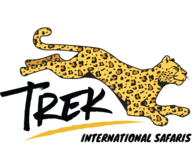To reach Patagonia River Ranch you need to fly into Buenos Aires's Ezeiza International Airport. Most flights into Ezeiza from the U.S. are overnight. There are a number of airlines and location with direct flights from the U.S. to EZE. We have chosen to use Miami for this sample itinerary.
Once you arrive into Ezeiza we will have a local agent from Gateways Travel greet you outside Customs and transfer across town (one hour) to the domestic airport Jorge Newberry to connect with a flight south to San Martin de los Andes (90 minutes). Once in San Martin de los Andes, staff from Patagonia River Ranch will greet you and transfer you to either the Ranch (45 minutes). Once you have been assigned a room a the fun begins.
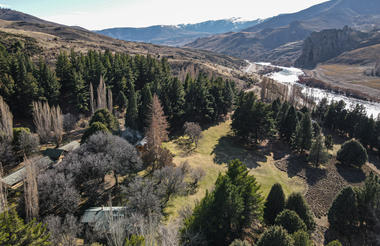
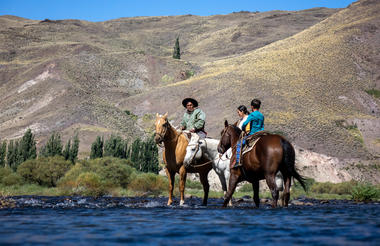
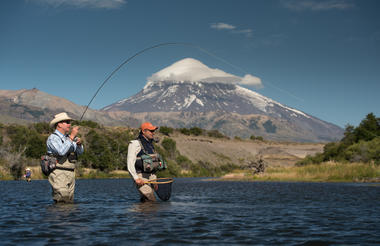
This will be six full fishing days from PRR. Each day after breakfast around 9:00 AM your guide will collect you and head out for a full day on the water. Using his knowledge of the area and patterns that are predominant, he will suggest the program best suited for your needs and abilities. Usually you will be back to the lodge in the late afternoon after a fun day with the Rainbows and Browns.
The Chimehuin River, which runs through the ranch, is commonly known as the finest trout stream for large fish in Northern Patagonia. The ranch's location in the center of the most productive 50 mile section of this river allows guest to float and wade-fish the "home water" from the nearest access point 20 miles upstream, and step off the boat at the end of the ay 100 years from the lodge. We also can put in at the ranch to fish the lower section. No fishing lodge or outfitter has the river location to accomplish this. Aside from the Chimehuin, the lodge an also access some of the most famous rivers in the region to include the Caleufu, Collon Cura, Alumine, Malleo, Quemquemtreu and the Quilqihue.
The lodge has an 9-person professional guide staff that is all native Argentine, and they work exclusively for the lodge. They have grown up fishing the native waters and know these rivers intimately. All guides are bi-lingual and have the ability to handle both the novice and expert angler with equal praise and patience.
It is most likely that you will be fishing one of eight different rivers systems and they are:
The Chimehuin River
Known to produce some of the largest freshwater German brown trout in Patagonia, the Chimehuin is one of the finest trout fisheries in the Americas. From its fabled mouth at the base of Lake Heuchulafquen, (also known as the boca, where fisherman dream of hooking into a one meter brown trout), the river winds its way through beautiful ranch lands, including past the town of Junin de los Andes, to its confluence with the Collon Cura River. The Chimehuin runs through the Patagonia River Ranch in the center of the most productive 50-mile section, allowing our guests to both float and wade-fish the river just 100 meters from our guest lodge. Often referred to as “the Cathedral of Patagonia Fly Fishing”, the river was made famous in the 1960’s by many fly fishing icons (Joe Brooks, Lefty Kreh, Mel Kreiger and Billy Pate), giving Argentina great notoriety as a world class fly-fishing destination. Known for its healthy populations of rainbow and German brown trout, a variety of willow-lined banks, incredible riffles, and deep pools offer the angler a variety of fishing conditions.
The Collon Cura River
Descending from the Andean Range across the Patagonia Steppe, the Collon Cura is a mild gradient river born at the confluence of the Alumine and Catan Lil Rivers. The water conditions, willow-lined banks, lush vegetation and volcanic rock provide ideal habitat for the terrestrial insect life that supports this rivers’ abundant trout population, while also boasting some of the regions’ largest trout. With its many different channels, broad gravel riffles, cut banks, and deep pools, the Collon Cura is a river full of possibilities where one can wade-fish pebble bottom stretches, drift through picturesque runs, and glide a streamer through a dark eddy line. It is said that the Collon Cura is home to some of the world’s hardest fighting rainbows, and legendary brown trout. Beyond the river banks, the spectacular scenery is complimented by an abundance of waterfowl, wild boars, red stags, and guanaco.
The Caleufu River
Above the Alicura Reservoir, the Caleufu flows approximately 60 miles through breathtaking mountain terrain in the Andes range. This is a fast-flowing waterway that will captivate you with its immense beauty and sensational fishing. During the day, the angler will experience three distinctly different terrain types, each with its own majestic and pristine beauty. Here, an abundance of rainbows and browns are found feeding on caddis, mayflies, stoneflies, and even pancora crabs, inviting a variety of productive dry fly, nymph and streamer fishing.
The Alumine River
Flowing through the northern reaches of the Neuquen Province, the Alumine originates from the waters of the Moquehue and Alumine Lakes. The river travels 160 miles, joining forces with the Malleo, where it forms the Collon Cura River. The lower stretch of the Alumine River, from the confluence of the Quillen, features an array of fishing habitat including large boulders, rocky steep cut and willow lined banks, and deep pools that support a world class fishery of incredibly strong rainbows and browns, giving way to larger brown trout as you travel downstream.
The Malleo River
From Lake Tromen in Lanin National Park, the Malleo River offers world-class wade fishing in three unique sections of unparalleled beauty. From the rocky cascading upper section filled with auraucaria trees and glimpses of the snow-capped Lanin Volcano, to the middle canyon section, and finally to the lower river that flows tranquilly through the desert valley, the Malleo is said to have some of the best dry fly fishing conditions in the world.
The Quilquihue River
From the outlet of Lake Lalog, this significant tributary of the Chimehuin is born. The Quilquihue offers both exceptional scenery along the Patagonia Steppe and ideal fishing conditions. This small and densely vegetated stream, which is in close proximity to San Martin de los Andes, supports heavy hatches throughout the fishing season and boasts large numbers of trout in the fast-flowing waterway.
The Quemquemtreu River
Formed from several clear, cold cascading streams, the Quemquemtreu River is a notable tributary of the Collon Cura and a favorite wading spot among anglers. Well known for its classic dry fly fishing environment, spectacular scenery along this well-protected waterway and an abundance of beautiful rainbows and the occasional large brown trout provide an exceptional fishing experience.
Rio Limay Medio
One of Northern Patagonia’s most remarkable trout streams, particularly for large fish, is the Rio Limay Medio (also known as the Middle Limay). This section of river – the only tailwater fishery in the region – features cool, stable water releases that create a rich habitat for a large and healthy fish population. It also provides abundant nourishment for several species of large minnows that migrate out of the very fertile Ezequiel Ramos Mejia Lake and up the river, which becomes food that helps grow some massive trout. Migratory brown and rainbows in the 30-inch+ range actually live here! And the year-round resident trout population runs from 18 to 25(+) inches.
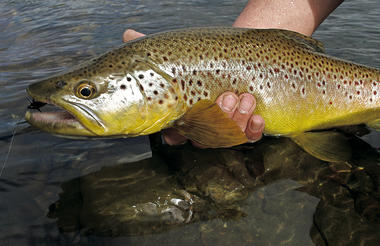
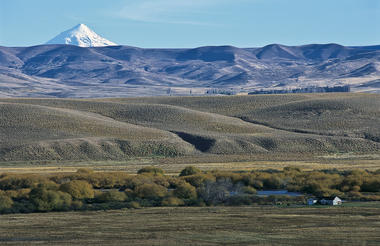
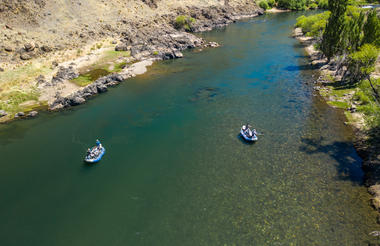
There is no fishing planned this day as you will have breakfast, settle up, and then transfer back to San Martin de los Andes and your flight to Buenos Aires's Jorge Newberry Airport where you will be collected by your agents and make the cross-town transfer to Ezeiza International and your overnight flight home.
Arrive to U.S.
